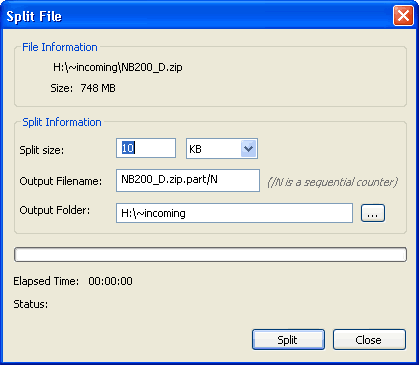Split File…

This function provides a useful operation - it splits the selected file into equal sized sub-files. While this may not seem that useful at first glance, many email providers, for example, have a limitation on the size of attachment that can be sent with a single message. If the file is over that size, then the server will automatically reject that message entirely; the file can be split, sent in parts, then re-assembled when received.
The companion function - Merge Files… - restores the original file by combining the sub-files.
Split size:
Enter the split size in the left box; set the units in the right box using the pulldown. Units are determined by the units drop-down list to the right and may be
Bytes,
KB kilobytes = 1024 (210) bytes,
MB megabytes = 1024 KB or 1,048,576 (220) bytes, or
GB gigabytes = 1024 MB or 1,073,741,824 (230) bytes.
The final size of the individual sub-files is a combination of the size and units selected.
Output Filename:
The output filename is actually a pattern for consecutive naming/numbering of the output files; the string “/N” (capital N only!) represents the variable numeric part of the future file names (e.g. 1, 2, 3, etc.). The default is <original filename>.part/N, which in the sample dialog above (original file = NB200_D.zip) would create sub-files of
NB200_D.zip.part.1
NB200_D.zip.part.2
NB200_D.zip.part.3
etc.
The sub-file naming pattern must contain a variable (i.e. /N) and the numeric variable portion of the new files always starts with 1.
Tip
Be careful with leading zeroes in the output filename; they are treated as constants. For example, using NB200_D.00/N as the pattern yields files NB200_D.001, NB200_D.002 but would also yield NB200_D.0010 instead of the anticipated NB200_D.010! Explorer++’ s Merge Files… routine can handle this naming, but other split/join applications may not behave properly.
Output Folder:
The output folder (where the sub-files will be placed) defaults to the same folder as the target file. The folder may be chosen by typing (the target folder must exist) or by using the … button to the right which opens a standard Browse for folder dialog (see here for a picture of this Windows dialog).
Split
Clicking the Split button commences the operation, creating sub-files of the specified size. The last file may not be the same size; it is simply the remaining portion of the original file. Files are named the same as the target file, but with a number appended, that is, if message.txt is split, sub-files will be message.txt.1, message.txt.2, and so on.
Note
If Split File… involves creating a large number of files (e.g. > 500), there may be delays in response, depending on the speed of your computer. Be patient - Explorer++ will finish the operations properly.